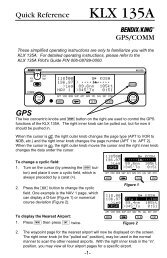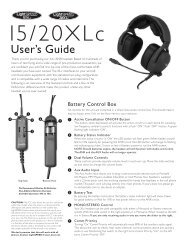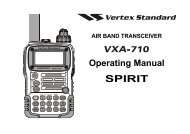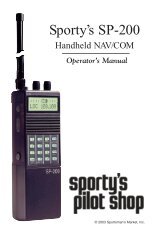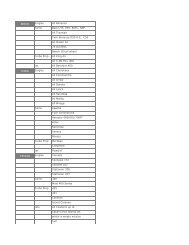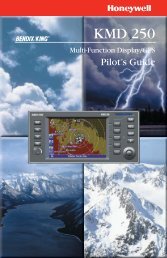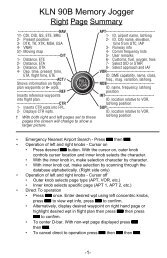You also want an ePaper? Increase the reach of your titles
YUMPU automatically turns print PDFs into web optimized ePapers that Google loves.
8Precautions This apparatus is capable of two-way communicationon channels used for critical aviation safety communications.Therefore, it is important that this radio bekept away from children or other unauthorized usersat all times. When making DC connections via the (optional)E-DC-5B/E-DC-6 DC cable, be absolutely certain toobserve the proper voltage level and polarity guidelines.Do not connect this radio directly to any 24 ~ 28 VoltDC source, nor to AC power of any kind. Connectingthe <strong>VXA</strong>-300 directly to a source which exceeds 15.0Volts DC will result in damage to the unit. The LimitedWarranty for this product does not cover damage causedby the application of improper voltage. Do not dispose of the Ni-MH Battery Pack in a fire.Do not carry a Ni-MH Battery Pack in your pocket,where keys or coins could short the terminals. Thiscould create a serious fire/burn danger, and possiblycause damage to the Ni-MH pack. Although the <strong>VXA</strong>-300 is designed to be Submersible(3 ft., 30 min.), its enclosure is not designed toguarantee protection from ingress of water under extremepressure. Do not allow the radio to become submergedin deep water, and do not subject it to waterspray under pressure.BEFORE YOU BEGINBelt Clip InstallationConnect the hanger to the rear of the <strong>VXA</strong>-300, withthe notch pointing directly up, using the supplied screw(Figure 1). Use only the screw included with the clipto mount the clip to the back of the <strong>VXA</strong>-300. Clip the Quick-Draw Belt Clip onto your belt (Figure2). To install the <strong>VXA</strong>-300 into the Quick-Draw Belt Clip,align the hanger with the Quick-Draw Belt Clip, andslide the <strong>VXA</strong>-300 into its slot until a click is heard(Figure 3). To remove the <strong>VXA</strong>-300 from the Quick-Draw BeltClip, rotate the <strong>VXA</strong>-300 180 degrees, then slide the<strong>VXA</strong>-300 out from the Quick-Draw Belt Clip (Figure4).<strong>VXA</strong>-300 PILOT III OPERATING MANUAL
BEFORE YOU BEGINBattery Installation and RemovalTo install the battery, insert the battery pack into thebattery compartment on the back of the radio, thenclose the Battery Pack Latch until it locks in placewith a “Click.”Figure 2Figure 1To remove the battery, turn the radio off and removeany protective cases. Open the Battery Pack Latch onthe bottom of the radio, then lift the battery upwardand out from the radio.Do not attempt to open any of the rechargeableNi-MH packs, as personal injury or damage tothe Ni-MH pack could occur if a cell or cells becomeaccidentally short-circuited.Figure 3Figure 4<strong>VXA</strong>-300 PILOT III OPERATING MANUAL9
Low Battery IndicationAs your battery discharges during use, the voltage willgradually become lower. When the battery voltagereaches 6.0 Volts, the “ ”icon will blink on the LCD display,indicating that the batterypack must be recharged beforefurther use.Avoid recharging Ni-MH batteries before the “LowBattery” indicator is observed, as this can degrade thecharge capacity of your Ni-MH battery pack. VertexStandard recommends that you carry an extra, fullychargedpack with you so you will not lose communicationscapability due to a depleted Ni-MH battery.BEFORE YOU BEGINInstalling the FBA-25A (option) AlkalineBattery CaseThe optional FBA-25A Battery Case allows operation ofthe <strong>VXA</strong>-300 using six “AA” size Alkaline batteries.When installing batteries, insert the (–) end first, then pressin the (+) end so the battery snaps into place. Always replaceall six batteries at the same time, paying attention tothe polarity indicated inside the case.The FBA-25A must not be used with rechargeablecells. The FBA-25A does not contain thethermal and over-current protection circuits (providedin the “FNB” series of Ni-MH Battery Packs) requiredwhen utilizing Ni-Cd and Ni-MH cells.<strong>VXA</strong>-300 PILOT III OPERATING MANUAL11
12Preliminary Steps Install a charged battery pack onto the transceiver, asdescribed previously. Screw the supplied antenna onto the Antenna jack.Never operate this transceiver without an antenna connected. If you have an optional Speaker/Microphone or headset,we recommend that it not be connected until youare familiar with the basic operation of the <strong>VXA</strong>-300.BASIC OPERATIONOperation Quick StartTo turn the radio on, rotatethe (inner) VOL-UME knob out of theclick-stop.A channel frequencyPressshould appear on the display.If not, press downward(momentarily) onthe VOLUME knob (repeatedly,if necessary) sothat “- VFO -” appearson the display, followed by a channel frequency.Directly entering frequencies from the keypad is theeasiest method if you know the frequency on whichyou wish to operate. Just enter the five digits of thefrequency to move to that frequency.For example, to set 134.35 MHz,press [1] [3] [4] [3] [5].To set 118.275 MHz, you do not need to press thefinal “5” in the frequency:[1] [1] [8] [2] [7].<strong>VXA</strong>-300 PILOT III OPERATING MANUAL
You may also turn thetop panel’s (outer) DIALselector knob to choosethe desired operatingfrequency. The channelfrequency will appear onthe LCD.Rotate the VOLUMEknob to set the volumelevel. If no signal ispresent, press and holdthe MONITOR switchfor 2 seconds; backgroundnoise will nowbe heard, and you mayuse this noise to set theVOLUME knob for thedesired audio level.Press the MONITORswitch momentarily tosilence the noise and resumenormal (quiet) monitoring.BASIC OPERATIONTo turn the radio off,turn the VOLUME knobfully counter-clockwiseinto the click stop position.Squelch AdjustmentPress the [F] key momentarily,then press the[0 (SQ)] key. This instantlyrecalls Menu Item01 “SQL” which is adjuststhe threshold levelof the squelch circuit.Rotate the DIAL selector knob to set the squelchthreshold (0 to 8) so that the receiver is just silenced.A higher number indicates that a higher signal level isrequired in order to open the squelch.Press downward on the VOLUME knob to save yournew setting.Press the PTT switch to exit the Menu (“SET”) mode.<strong>VXA</strong>-300 PILOT III OPERATING MANUAL13
Accessing the 121.5 MHz Emergency FrequencyThe <strong>VXA</strong>-300 can quickly access the 121.500 MHz EmergencyFrequency. This function can be activated even whenthe keypad lock function (described on page 14) is in use.To access the EmergencyFrequency, pressthe [121.5] key momentarily.To exit the EmergencyFrequency, press downwardon the VOLUMEknob.BASIC OPERATIONTransmissionOperating Advice: Use of Internal MicrophoneYour <strong>VXA</strong>-300 is extensively sealed against water ingress, so as to ensure reliable operationeven if it has become submerged. This unique construction includes waterproofingseals around the microphone and speaker enclosure, requiring that care be exercised whenspeaking into the internal microphone.Please refer to the illustration, and observe the location of the internal microphone. It isimportant that you focus your speech in the direction of the microphone's location, so as toensure sufficient voice input to the radio.To transmit, press and hold the PTT switch. Speakinto the microphone areaof the front panel grillein a normal voice level.To return to the receivemode, release the PTTswitch.14If you find it difficult to utilize the <strong>VXA</strong>-300 conveniently and safe while speaking directlyinto the microphone, we recommend the use of the MH-44B4B Speaker/Microphone (option),or an after-market aviation headset/boom microphone.<strong>VXA</strong>-300 PILOT III OPERATING MANUAL
Tuning MethodsThroughout this manual, you will see references to severaldifferent frequency setting methods. Each will be particularlyuseful in a particular operating situation, and theyare described below:VFO (Variable Frequency Oscillator)The VFO is a “tuning dial”system which allows you totune through the NAV or COMbands using the DIAL selector,the Keypad, or the scanner. The <strong>VXA</strong>-300 has twoVFOs which are called VFO-A and VFO-B. Press the[SCAN(DW)] key momentarily to switch betweenVFO-A and VFO-B. You may set VFO-A to the NAVband, and VFO-B to the COM band, if you like.MR (Memory Recall)The MR (Memory Recall)mode of the <strong>VXA</strong>-300 providesthe user with the abilityto store and recall as many as150 channels in the radio’s main memory bank. Thesememory channels may also be labeled by you with analpha/numeric name of up to 8 characters in length, toaid in quick identification of the channel. See page 28for details on creating alpha/numeric labels.<strong>VXA</strong>-300 PILOT III OPERATING MANUALADVANCED OPERATION BOOK (Pre-Programmed) MemoriesThe Book memories are preprogrammed,either at the factoryor by your Dealer (dependingon your country’s requirements),typically including the major COM andNAV band station frequencies used in your area. TheBook memories can be changed by the user. See page42 for details. WX (Weather Channel) Memories (USA version only)Ten Weather Channels are pre-programmed at the factory.The <strong>VXA</strong>-300 will automaticallyscan this specialbank when it is selected by theuser.VFOWX( USA version only)PressMRBOOK15
16Reception of Weather Channel Broadcasts(USA version only)The <strong>VXA</strong>-300 can receive VHF Weather Channel broadcasts,which may assist your flight planning. The <strong>VXA</strong>-300 includes a ten-channel auto-search feature, which simplifiesaccess to Weather Channels when you are in anunfamiliar location.To receive WeatherPressChannels, press theVOLUME knob (repeatedly,if necessary)to select the WeatherChannel mode. In theWeather Channel mode,“- WX -” will appear on the display.The <strong>VXA</strong>-300 will now scan quickly through the tenstandard Weather Channels, and will stop on the firstactive station found.If there are two or more weather channels audible inyour area, you may select the alternate channel(s) bypressing the PTT switch. Pressing the PTT switch reinitiatesthe scanning process.If there are no Weather Channels in your area, the scannerwill not stop. Press the MONITOR switch to stopthe scanner.ADVANCED OPERATION You can also select Weather Channels manually byrotating the DIAL selector knob. To confirm the current Weather Channel frequency,press the [ ( )] key momentarily. The displaychanges to frequency indication. Press the [ ( )]key again to return to normal display. To exit the Weather Channel mode, press the VOL-UME knob momentarily to return to the VFO mode.Note 1: In the event of extreme weather disturbances, suchas storms and hurricanes, the NOAA (National Oceanicand Atmospheric Administration) sends a weather alertaccompanied by a 1050 Hz tone and subsequent weatherreport on one of the NOAA weather channels. You maysetup the Alert function when receiving the Weather Alertsignal via Menu Item 20 “WXAF,” if desired. See page 50for details.Note 2: The Weather Channel mode memorizes the lastWeather Channel you have used, and will retain this informationuntil the radio is turned off.<strong>VXA</strong>-300 PILOT III OPERATING MANUAL
Monitor SwitchWhen listening to a very weak signal from an aircraft orground station, you may observe the signal disappearingperiodically as the incoming signal strength becomes tooweak to override the squelch threshold setting.To disable the squelch temporarily, press and hold theMONITOR switch for 2 secondson the left side of theradio, just below the PTTswitch. The squelch will remainopen and you shouldhave a better chance of hearingweak signals.To return to normal operation, press the MONITOR switchmomentarily.ADVANCED OPERATIONANL (Automatic Noise Limiter) FeatureFor reduction of impulse noise, such as that produced byan engine’s ignition system, the ANL feature may provehelpful. The ANL feature is only activated in the AM mode.To activate the ANL feature,press the [USER]key momentarily. The“ ” icon will appearon the display, and youshould observe a reductionin the ignition noise.To turn the ANL feature off,repeat the above step; the“ ” icon will disappearfrom the display.<strong>VXA</strong>-300 PILOT III OPERATING MANUAL17
Temperature/Battery Voltage DisplayThe <strong>VXA</strong>-300 can measure the current temperature insidethe transceiver’s case and current battery voltage.To display these items,press the [F] key momentarily,then press the[6 (SENSR)] key.The display will now indicatethe current temperatureinside thetransceiver’s case or currentbattery voltage.Press the VOLUMEknob to switch the displaybetween “currenttemperature” and “currentbattery voltage.”PressADVANCED OPERATIONWhen the <strong>VXA</strong>-300 display“current temperature,”pressing the[ ( )] key to switchthe temperature unit between“Celsius: °C” and“Fahrenheit: °F.”To return to the normal operation, press [F] [6 (SENSR)] again.If the temperature display is incorrect, it can be re-calibratedvia Menu Item 14 “TEMP.” See page 49 for details.18<strong>VXA</strong>-300 PILOT III OPERATING MANUAL
LOCK FunctionThe lock function prevents accidental changes to the frequencysetting and the keypad controls. To activate the lock feature,press the [F] keymomentarily, then pressthe [ ( )] key. In the LOCK mode, thedisplay will show“- LOCK -” when yourotate the DIAL selector knob, press the VOLUMEknob, or touch a key on the keypad. To turn the lock feature off, press [F] [ ( )]again. You can still access the 121.500 MHz Emergency Frequencywhen the LOCK function is on.Simply press the [121.5] key momentarily (this keynever locks). Pressing this key also unlocks the radio.You may choose the lockout configuration according toyour operating preferences. See page 51 for details.<strong>VXA</strong>-300 PILOT III OPERATING MANUALADVANCED OPERATIONBeep On/OffThe <strong>VXA</strong>-300’s key/button beeper provides convenientaudible feedback whenever a button is pressed. Each keyand button has a different beep pitch, and each functionhas a unique beep combination.When you are scanning, the beeper will be heard each timethe scanner halts on a busy channel. This may be distractingin some environments; if you want to turn the beeperoff (or back on again): Press the [F] key, then press the VOLUME knob toactivate the Menu (“SET”) mode. Rotate the DIAL selector knob to select Menu Item05 “BEEP.” Press the VOLUME knob to enable adjustment of thisMenu item. Rotate the DIAL selector knob to select the desired“beeper.” The selections available are on, DTM, andoFF.on: Sounds a beep corresponding to a musical note.DTM: Sounds a beep corresponding to a DTMF tone.oFF: Disables the key beeper. When you have made your selection, press the VOL-UME knob to save the new setting, and then press thePTT key to exit to normal operation.19
20Receive Battery Saver SetupAn important feature of the <strong>VXA</strong>-300 is its Receive BatterySaver, which “puts the radio to sleep” for a time interval,periodically “waking it up” to check for activity. Ifsomebody is talking on the channel, the <strong>VXA</strong>-300 willremain in the “active” mode, then resume its “sleep” cycles.This feature significantly reduces quiescent battery drain,and you may change the amount of “sleep” time betweenactivity checks using the Menu System: Press the [F] key, then press the VOLUME knob toactivate the Menu (“SET”) mode. Rotate the DIAL selector knobto select Menu Item 06“RSAV.” Press the VOLUME knob toenable adjustment of this Menu item. Rotate the DIAL selector knob to select the desired“duty cycle” (receive:sleep). The selections availableare 1:1, 1:2, 1:3, 1:4, 1:5, and ABS or oFF. Thedefault value is 1:1. When you have made your selection, press the VOL-UME knob to save the new setting, and then press thePTT key to exit to normal operation. ABS: Automatic Battery Saver, based on activity onthe receiver.ADVANCED OPERATIONThe setting of 1:5 will promote the greatest conservationof battery capacity, but the receiver’s response time to incomingcalls will be slowed somewhat.Note: This feature does not operate during Scan or DualWatch.<strong>VXA</strong>-300 PILOT III OPERATING MANUAL
Changing the Channel StepsThe <strong>VXA</strong>-300’s synthesizer provides the option of utilizingchannel steps of 8.33/25 kHz per step.The <strong>VXA</strong>-300 is set up with default channel steps of “25kHz” (NAV and COM bands). If you need to change thechannel step increments, the procedure to do so is veryeasy.First set the <strong>VXA</strong>-300 to the operating band (VFO Aor VFO B and NAV or COM) on which you wish tochange the channel steps.Press the [F] key, then press the VOLUME knob toactivate the Menu (“SET”) mode.Rotate the DIAL selector knobto select Menu Item 30“STEP.”Press the VOLUME knob toenable adjustment of this Menu item.Rotate the DIAL selector knob to select the new channelstep size.When you have made your selection, press the VOL-UME knob to save the new setting, and then press thePTT key to exit to normal operation.ADVANCED OPERATIONImportant Note1) When you set the channel step to 8.33 kHz, the channeldisplay differs from actual operating frequency; see thechart below. However, the operator (pilot, tower, control,etc) will call out the frequency according to whatthe display indicates.When you set the channelsteps to 8.33 kHz, the “ ”icon will appear in the display.OperatingFrequency1xx.0000 MHz1xx.0083 MHz1xx.0166 MHz1xx.0250 MHz1xx.0333 MHz1xx.0416 MHz1xx.0500 MHz1xx.0583 MHz1xx.0666 MHz1xx.0750 MHz1xx.0833 MHz1xx.0916 MHz8.33 kHz Step1xx.005 MHz1xx.010 MHz1xx.015 MHz1xx.030 MHz1xx.035 MHz1xx.040 MHz1xx.055 MHz1xx.060 MHz1xx.065 MHz1xx.080 MHz1xx.085 MHz1xx.090 MHzDisplay25 kHz Step1xx.000 MHz1xx.025 MHz1xx.050 MHz1xx.075 MHz2) The 8.33 kHz step allows the radio to receive only,and the transmit function is disabled.3) The adjacent channel selectivity will be slightly degradedwhile receiving using 8.33 kHz channel steps.<strong>VXA</strong>-300 PILOT III OPERATING MANUAL21
22Pitch ControlThe <strong>VXA</strong>-300 includes a feature that lets you choose fourspecial receiver audio responses to allow the most comfortableand/or effective reception in noisy environments.The effect is similar to that provided by an “Equalizer” ina stereo.Press the [F] key momentarily,then press the[5 (PITCH)] key. Thisinstantly recalls MenuItem 31 “PIT” which selectsthe receiver audioresponses.Rotate the DIAL selector knobto select desired receiver audioresponse. Available selectionsare:oFF: The received audio signal does not pass throughthe equalizer circuit.MD1: The received audio is passed without roll-offon the high or low ends.MD2: The received audio is enhanced in the low- andmid-range frequencies.MD3: The received audio is enhanced in the mid- andhigh-range frequencies.ADVANCED OPERATIONUSR: The received audio is shaped per a user-configuredaudio response programmed via MenuItems 26 “UP_L,” 27 “UP_M,” and 28“UP_H.” The default setting enhances the audioin the lower frequency range, and reducesthe level of the higher-frequency components.When you have made your selection, press the VOL-UME knob to save the new setting, and then press thePTT key exit to normal operation.SELECTIONoFFMD1MD2MD3USERRESPONSENormalFull BoostLow BoostHigh BoostDefaultLOW-RANGE0++–+MID-RANGE0+++0HIGH-RANGE0+–+–<strong>VXA</strong>-300 PILOT III OPERATING MANUAL
VOX OperationIf you want to have both hands free, use the (user-supplied)Headset and activate the VOX (voice-actuated transmit/receiveswitching) system.Note: The VOX system does not function when using justthe internal microphone; an external headset must be used.To activate the VOX system using the Menu System: Press the [F] key, then press the VOLUME knob toactivate the Menu (“SET”) mode. Rotate the DIAL selector knobto select Menu Item 21 “VOX.” Press the VOLUME knob toenable adjustment of thisMenu item. Rotate the DIAL selector knob to select “on” (to enablethe VOX system). When you have made your selection, press the VOL-UME knob to save the new setting, and then press thePTT switch to exit to normal operation. Without pressing the PTT switch, speak into the microphonein a normal voice level. When you startspeaking, the transmitter should be activated automatically.When you finish speaking, the transceiver shouldreturn to the receive mode (after a short delay).ADVANCED OPERATIONTo cancel VOX and return to PTT operation, just repeatthe above procedures, selecting “oFF” in step 4 above.When the VOX system is activated,the “ ” icon will appear on thedisplay.The <strong>VXA</strong>-300 provides for adjustment of the VOX Gainvia the Menu, to prevent accidental transmitter activationin a noisy environment. To set the VOX Gain: Press the [F] key, then press the VOLUME knob toactivate the Menu (“SET”) mode. Rotate the DIAL selector knobto select Menu Item 23“VSNS.” Press the VOLUME knob toenable adjustment of this Menu item. While speaking into the microphone, rotate the DIALselector knob to the point where the transmitter isquickly activated by your voice, without causing backgroundnoise to activate the transmitter. When you have selected the optimum setting, pressthe VOLUME knob to save the new setting, and thenpress the PTT switch to exit to normal operation.<strong>VXA</strong>-300 PILOT III OPERATING MANUAL23
24The <strong>VXA</strong>-300 also provides for adjustment of the “Hang-Time” of the VOX system (the transmit-receive delay afterthe cessation of speech) via the Menu. The default delayis 1.0 second. To set a different delay time: Press the [F] key, then press the VOLUME knob toactivate the Menu (“SET”) mode. Rotate the DIAL selector knobto select Menu Item 22“VDLY.” Press the VOLUME knob toenable adjustment of this Menu item. Rotate the DIAL selector knob to select the delay timeamong “05,” “10,” “15,” and “20” (representing 0.5,1.0, 1.5, and 2.0 sec). When you have made your selection, press the VOL-UME knob to save the new setting, and then press thePTT switch to exit to normal operation.ADVANCED OPERATIONPA OperationThe PA mode allows the <strong>VXA</strong>-300 to be used as a PublicAddress System when an optional MH-44B4B Microphoneor other Headset/Microphone is connected. Press and hold in the[USER] key for 2 secondsto activate the PAmode. Speak through the microphonewhile pressingand hold in the PTTswitch on the microphone or headset/microphone.The “Course Deviation Needle”will defect in accordance withthe voice level. Rotate theVOLUME knob to control theaudio output level. To exit the PA mode, press and hold in the [USER]key again.The <strong>VXA</strong>-300 provides for customization of the voicemonitor feature via the Menu while using a Headset. Toselect the monitor configuration:Press the [F] key, then press the VOLUME knob toactivate the Menu (“SET”) mode.<strong>VXA</strong>-300 PILOT III OPERATING MANUAL
Rotate the DIAL selector knobto select Menu Item 25“PAMO.”Press the VOLUME knob toenable adjustment of this Menu item.Rotate the DIAL selector knob to select the desiredmonitor mode.oFF: Disables the monitor function at all times.PA: Feeds back your voice to the headset whileyou’re pressing the PTT switch.ALL: Feeds back your voice to the headset whileyou’re pressing the PTT switch. When the PTTswitch is off, you may monitor the sound aroundthe transceiver (the monitor will pick up thebackground sound using the <strong>VXA</strong>-300’s internalmicrophone).When you have made your selection, press the VOL-UME knob to save the new setting, and then press thePTT switch to exit to normal operation.Note: Do not activate the voice monitor feature while usingwith the optional MH-44B4B Microphone. The voicemonitor feature will tend to produce “howling” due to feedback.ADVANCED OPERATION<strong>VXA</strong>-300 PILOT III OPERATING MANUAL25
Timer OperationThe <strong>VXA</strong>-300 is provided a “Stop Watch” timer and a“Count Down” timer. These can be used for a variety oftime-keeping purposes.Press the [F] key momentarily,then press the[8 (TIMER)] key to activatethe Timer Mode.ADVANCED OPERATION If you select the “Count Down” timer, rotate the DIALknob to set the values for the timer (1 minutes - 60minutes). The Timer is designed to start/stop/reset repeatedlywhenever you press the VOLUME knob. In the “Count Down” timer mode, an alert will soundand the timer will stop when the “Count Down” timerreaches “00 00 00.” To disable the Timer Mode, press [F] [8 (TIMER)]again. Press the [ ( )] keytoggle the Timer betweenthe “Stop Watch”and “Count Down”timer modes.“Stop Watch” mode“Count Down” timer mode26<strong>VXA</strong>-300 PILOT III OPERATING MANUAL
NoteADVANCED OPERATION<strong>VXA</strong>-300 PILOT III OPERATING MANUAL27
28MEMORY OPERATIONThe <strong>VXA</strong>-300 provides 150 user-programmable “Main”memories, labeled “CH-001” through “CH-150,” and upMemory Storageto 100 pre-programmed memories, designated “Book”Memories. The “ ” icon appears when the “Book” be stored in the Main Memory.Memory Mode is activated.The Main memories and “Book” Memories can be assignedalpha-numeric names of up to eight characters. Press and hold in the[MW (SPL-W)] key for2 seconds. The displaywill indicate “CH-XXX”and a channel numberwill blink on the LCD.Memory System OperationThe <strong>VXA</strong>-300’s Main Memory system allows the user tostore, label, and recall channel frequencies which you maywant to use frequently. You may store VFO frequencies,Book Memory frequencies, and/or Weather Channel frequencies(USA version only) into the Main Memory system.Select the desired frequency in the VFO mode, or recallthe Book Memory channel or Weather channel to Within five seconds ofpressing the [MW (SPL-W)] key, rotate the DIALselector knob to select the desired memory channelnumber for storage.In order to prevent writing over memory channels, asmall “ ” icon will appear atthe right side of the channelnumber to indicate a vacantmemory channel. Now press and hold in the [MW (SPL-W)] key for 2seconds; you will now see blinking “A” on the LCD.To attach an alpha/numeric name (label) to thememory, proceed to the next step; otherwise press andhold in the [MW (SPL-W)] for 2 seconds to save theentry and exit.<strong>VXA</strong>-300 PILOT III OPERATING MANUAL
To label a memory with an alpha/numeric name, thenext step is to use the DIAL selector knob to selectany of the 48 available characters (including letters,numbers, and special symbols). When the desired firstcharacter appears, press the VOLUME knob momentarilyto move on to the next character.Select succeeding characters in the same manner,pressing the VOLUME knob momentarily after eachselection.After entering the entire name (eight characters maximum),press the [MW (SPL-W)] key for 2 seconds tosave all data for the channel and exit.Note: If you have transferred a Weather Channel directlyto memory, the “WX-001 ~ WX-010” labels utilize thealphanumeric memory, and other labels may not be stored.But if you go to the VFO mode, and dial up or key in theweather station’s frequency manually, you may then storethe frequency and a custom alpha-numeric label yourself.MEMORY OPERATIONRecalling the MemoriesPress the VOLUME knob, repeatedly if necessary,until “- MR -” (Memory Recall) appears on the display.In the MR mode, you will see “CH-” and thepreviously selected channel number appearing on theLCD.Rotate the DIAL selector knob to select the desiredmemory channel.You may change the title structure of the Memory displaytype among:1. Channel Indication (sequential Channel Number,e.g. CH-001, CH-002, etc.);2. Frequency Indication (e.g. 122.500); or3. Alphanumeric Label (e.g. LAX FSS).To change the Memory display title, press the[ ( )] key repeatedly, if necessary, until you getthe desired display title structure.To exit the Memory mode, press the DIAL selectorknob three times to return to the VFO mode.Note: In either the “MR” or the “Book” Memory mode,an easy way to recall memories is to key in the memorychannel number, then press the [SCAN (DW)] key. Forexample, to recall memory channel #14, press [1] [4] [SCAN (DW)].<strong>VXA</strong>-300 PILOT III OPERATING MANUAL29
30The <strong>VXA</strong>-300 allows you to scan automatically in theVFO 1 , Main Memory, “Book” Memory, or WeatherChannel 2 modes. It pauses on signals encountered, so youcan talk to the station(s) on that frequency, if you like.1: In the VFO mode, the automatic scanner is only availablein the COM band (118.000 ~ 136.975 MHz);when the scanner reaches the uppermost frequency inthe COM band, it will revert to the bottom end of theCOM band and repeat the scanning process until youcancel the scanning process.2: USA version only.If you wish to scan in the NAV band (108.000 ~ 117.975MHz), you can do so manually, as described at the right.Scanning operation is basically the same in each of theabove modes.Press and hold in the[SCAN (DW)] key for 2seconds to start the automaticscanner upward(toward a higher frequencyor a higher channelnumber).When the scanner encounters a signal, scanning pausesand the radio remains on that channel until one sec-SCANNING OPERATIONond after the signal disappears, after which scanningwill resume. While the scanner remains paused on a frequency, thedecimal point of the frequency display blinks. The displaywill be illuminated unless the Scan Lamp Featureis turned off. To change the scan direction,turn the DIALselector knob one clickin the opposite direction. To stop the automaticscanner, press the PTTswitch or the VOLUMEknob momentarily. You may also just press the [SCAN(DW)] key.The <strong>VXA</strong>-300’s automatic scanner is not operational inthe NAV band (108.000 ~ 117.975 MHz), because the NAVstations (ILS, etc.) transmit constantly (thereby causingthe scanner to stop repeatedly). However, you can scanmanually in the NAV band, per the following procedure:Press and hold the [SCAN (DW)] key to start themanual scanner. Scanning will continue as long as thekey is depressed.Release the [SCAN (DW)] key to stop the manualscanner immediately.<strong>VXA</strong>-300 PILOT III OPERATING MANUAL
Note: When scanning upward in frequency, when the frequencyreaches the COM Band (118.000 ~ 136.975 MHz)via manual scanning, the <strong>VXA</strong>-300 will switch to the automaticscanner mode.Channel-Skip ScanningContinuous-carrier stations like ATIS (Automatic TerminalInformation Service) or Weather Broadcast stationsinhibit scanner operation. Since these stations are alwaysactive, the scanner will be halted repeatedly on their channels.Such channels can be set to be “skipped” duringMemory scanning (MR, Book or WX modes), if you like,so as not to interfere with automatic channel scanning: Recall the Memory Channel to be skipped during scanning. Press the [F] key momentarily,then press the[9 (SKIP)].The “ ” icon willappear at the upper rightof the channel number,indicating that the channelis to be ignored duringscanning. You can also designate a channelto be skipped while scan-<strong>VXA</strong>-300 PILOT III OPERATING MANUALSCANNING OPERATIONning. When the receiver is halted on a channel thatyou wish to skip, press and hold the [SCAN (DW)]key for 2 seconds (the “ ” icon will appear nextto the channel to be skipped).Later, to re-enable the memory channel for scanning,repeat the first two steps. The “ ” icon will disappearby the channel you have just re-enabled.Note: A memory set to be “skipped” is still accessible formanual memory selection using the DIAL selector knob.31
32The Dual Watch feature automatically checks for activityon a “priority” channel while you are operating on anotherchannel. During Dual Watch operation, the currentchannel and the Priority channel will each be polled for a500 ms interval, as the <strong>VXA</strong>-300 looks for activity on eachchannel.To start Dual Watch,press the [F] key momentarily,then press the[SCAN (DW)].The “ ” icon will appearon the display.While receiving on the“current” channel (not the Prioritychannel), you may pushthe PTT switch at any time totransmit on that channel.When a signal is received on the Priority channel, operationimmediately shifts to the Priority channel, the“ ” icon will blink, and the display will becomeilluminated.While receiving on the priority channel, if you momentarilypress the PTT switch, Dual Watch will be disabled.You may then transmit on the Priority Channel.To stop Dual Watch, press [F] [SCAN (DW)].DUAL WATCH OPERATIONIf you wish, you may use both the Dual Watch andScan features simultaneously. To do this, start the DualWatch first, then start the Scanner.: The “priority” Channel is defined as the last-usedMemory Channel (when using the VFO mode) or MemoryChannel 1 (when using the Main Memory or Book Memorymodes).<strong>VXA</strong>-300 PILOT III OPERATING MANUAL
Similar to Dual Watch operation (described on previouspage), Priority Dual Watch is an enhanced version whichincludes the following additional features:The receiving time interval (ratio) between the currentchannel and the Priority channel may be customizedvia Menu Item 09 “PRTM.” See page 47 for details.Irrespective of which channel is currently being received,when the PTT button is pushed transmissionwill always occur on the Priority channel.Before initiating Priority Dual Watch, Menu Item 10“DWMD” must be set to the “PRI: Priority” mode (insteadof “DW: Dual Watch”). See page 48 for details.<strong>VXA</strong>-300 PILOT III OPERATING MANUALTo start Priority DualWatch, press the [F] keymomentarily, then pressthe [SCAN (DW)]. The“ ” icon will appearon the display.While receiving on the“current” (non-Priority) channel,pressing the PTT buttononce causes the radio to switchto the Priority channel and can-PRIORITY DUAL WATCH OPERATIONcels Dual Watch. Press the PTT button again to transmiton the Priority channel. When a signal is received on the Priority channel, receptionimmediately shifts to the Priority channel, the“ ” icon will blink, and the display will becomeilluminated unless the Scan Lamp Feature is turnedoff.While receiving on the priority channel, if you momentarilypress the PTT button, Priority Dual Watchwill be disabled. You may then transmit on the PriorityChannel. To stop Priority Dual Watch, press [F] [SCAN (DW)].33
VOR NAVIGATIONGeneral VOR Equipment30033003060COURSE IndicatorCOURSE Deviation NeedleTWO-Degree Deviation Marks240FROM120“TO”-“FROM” Flag IndicatorOBS210180150COM Band(118.000 - 136.975 MHz)NAV Band (108.000 - 117.975 MHz)DVOR MODECDI MODECOURSE IndicatorCOURSE IndicatorCOURSE Deviation Needle“TO”-“FROM” Flag IndicatorOVERFLOW Indicator“TO”-“FROM” Flag Indicator34<strong>VXA</strong>-300 PILOT III OPERATING MANUAL
VOR NAVIGATIONTo Select the DVOR Mode When entering the NAV band (108.000 - 117.975MHz), the <strong>VXA</strong>-300 selects the DVOR mode automatically.The “COURSE INDICATOR” field will appearat the upper left corner on the display, and the “ ”or “ ” indicator will appear below the “CourseIndicator” field on the display.Note: The “COURSE INDICATOR” indicates “ ” wheneither your aircraft is too far away from the VOR stationor the frequency is not correctly set to that of the VORstation. Conversely, the “Course Indicator” will indicate“ ” when a localizer signal is being received. The “ ” or “ ” flag indicators tell you whetherthe VOR navigation information is based on a courseleading to the VOR station or leading away from theVOR station. To change the flag from “ ” to “ ” or vice versa,press the [F] key momentarily, then press the[3 (FROM)] or [2 (TO)] key, respectively. The small “COURSE INDICATOR” and “ / ” flagindicators may be toggled to the larger “Frequency”portion of the display. To do this, press and hold inthe [ ( )] key for 2 seconds to toggle to the largerdisplay area. Press the [ ( )] key momentarilyagain to return to the smaller displays.<strong>VXA</strong>-300 PILOT III OPERATING MANUALCOURSE Indicator“TO”-“FROM” Flag Indicator( 2 seconds)35
VOR NAVIGATIONFlying to a VOR StationThe <strong>VXA</strong>-300 can indicate the deviation from the directcourse to a VOR station.Select a VOR station on your aeronautical chart andturn the DIAL selector knob (or enter the frequencydirectly with the keypad) to the frequency of the VORstation.To indicate the deviation between your current flightpath and the desired course, press the [F] key momentarily,then press the [4 (CDI)] key to change tothe CDI (Course Deviation Indicator) mode. The“COURSE DEVIATION ARROW” will appear above thefrequency field on the display when your aircraft isoff the direct course to the VOR station.When your aircraft is off course to the right, the CourseDeviation Arrow display will show bars to the left sideof the diamond (“ ”). When your aircraft is offcourse to the left, the Course Deviation Arrow displaywill show bars to the right side of the diamond(“ ”). Correct your course until no bars appearon either side of the CDI “Diamond” (only “ ”) willbe visible when the heading is correct).To return to the DVOR mode, press the [F] key momentarily,then press the [1 (DVOR)] key.The Aircraft is “ON COURSE”OFF COURSE to the “right” 6 degreesOFF COURSE to the “left” 6 degrees36<strong>VXA</strong>-300 PILOT III OPERATING MANUAL
VOR NAVIGATIONThe Aircraft is “ON COURSE”<strong>VXA</strong>-300 PILOT III OPERATING MANUALAircraft should beheading 50°220°140°210°150°200°160°190° 170°180°Aircraft Heading 56°(6° off course)Flown course270°260°250°240°230°280°300°290°310°320°330°340° 350°10°250°240°230°220°140°210°150°200°160°190° 170°180°Desired CourseAircraft Heading 50°VORStation260°270°290°280°300°VOR ( TAC )Los AngelesLAX - 113.600MHzThe Aircraft is “OFF COURSE”VOR ( TAC )Los AngelesLAX - 113.600MHzVORStation0°310°320°330°340°350°0°10°130°20°130°20°90°100°110°120°80°70°50°60°30°40°90°100°110°120°80°70°50°60°30°40°NNMagneticNorthMagneticNorth37
Entering a Desired CourseThe <strong>VXA</strong>-300 can also be configured to indicate the deviationfrom the desired course, not only the deviation fromthe path to the VOR station. Set the frequency to the desired VOR station. Change the “ ” or “ ” flag to “ ,” if it is notin that mode already. Press [F] à [4 (CDI)] key to change to the CDI mode. Set the desired course to the VOR station using theDIAL selector knob or keypad (three digits are required;e.g. for 47°, press [0] [4] [7]).Note 1: The (“ ”) or (“ ”) indication willappear on the display when your aircraft is off the desiredcourse.Note 2: When your heading is correct, the ABCS functionmay be more useful than the course input option The Course Deviation Arrow points to the right whenyour aircraft is off course to the left, and it points tothe left when your aircraft is off course to the right.VOR NAVIGATIONNote 1: To get back on course, fly right more than thenumber of degrees indicated by the Course Deviation Arrow.Note 2: If the overflow indicator “” appears on the rightside, select a heading plus 10 degrees to the desired course;if the overflow indicator “⊳” appears on the left side, selecta heading minus 10 degrees.38ABCS ModeIn the CDI mode, the Auto Bearing Center System(ABCS) adds or subtracts the number of degrees indicatedby the CDI from the Omni Bearing Selector(OBS).<strong>VXA</strong>-300 PILOT III OPERATING MANUAL
Position Cross-checkingSelect two VOR stations on your aeronautical chart.Set the frequency of one of the VOR stations in theDVOR mode. The course indicator will show thecourse deviation from the VOR radial. Note the radialyou currently are on.VOR NAVIGATIONNow set the frequency of the other VOR station in theDVOR mode. Note the radial from the station you areon.Extend the radials from each VOR station on the chart.Your aircraft is located at the point where the linesintersect.280°270°290°350°340°330°320°310°300°0°10°20°30°40°50°60°NMagneticNorth280°270°290°350°340°330°320°310°300°0°10°20°30°40°50°60°NMagneticNorth260°70°260°70°250°240°VORStation230°220°140°210°150°200°160°190°180°170°80°90°100°110°120°130°VOR ( TAC)Long BeachSLI - 115.700MHz250°VORStation240°230°130°220°140°210°150°200°160°190°180°170°80°90°100°110°120°VOR ( TAC)Los AngelesLAX - 113.600MHz<strong>VXA</strong>-300 PILOT III OPERATING MANUALCross-checking Position39
40Split OperationThe split operation feature allows you to transmit a call toa Flight Service Station using the COM band frequencies,while receiving a VOR station (in the NAV band). VORstations equipped with this capability typically are shown,on navigation charts, with the voice calling frequency inparenthesis above the navigation frequency.Programming a Transmit Frequency Press the VOLUME knob, repeatedly if necessary, toselect the VFO mode. Set a NAV band (108.000 - 117.975 MHz) frequencyusing the DIAL selector knob or keypad. Press the [F] key momentarily, then press the [MW(SPL-W)] key. The “ ” icon will blink, and thetransmit frequency will appear on the display. Now set your radio’s transmit frequency, where theFlight Service Station will be listening for calls, usingthe DIAL selector knob or keypad. Press and hold in the [MW (SPL-W)] key for 2 secondsto save the transmit frequency and return to theNAV band frequency.Note: You have now stored the separate transmit frequency,but you have not yet activated the split-frequency function;go on to the next section.VOR NAVIGATIONOperating in the Split Mode It is assumed that you have already set the desiredVOR station’s frequencies (in the NAV band) per theabove instructions. Press the [F] key momentarily,then press the [7 (SPL)] keyto turn on the “Split” function.The “ ” icon will appearon the display. Press and hold in the PTT switch to transmit on thesplit transmit frequency. Release the PTT switch to return to the receive mode. To disable the “Split” function, press [F] [7 (SPL)]again.Note: A split frequency can be programmed into eachmemory channel independently. Set a transmit frequencybefore programming the memory channel, if desired. Thesplit function on/off setting can also be programmed intoa memory channel.<strong>VXA</strong>-300 PILOT III OPERATING MANUAL
PROGRAMMING THE USER KEY ASSIGNMENTSDefault <strong>VXA</strong>-300 functions have been assigned to “Primary”(press) and “Third” (press and hold in) function ofthe front panel’s [USER] key at the factory. These may bechanged by the user, if you wish to utilize another functionon this key.To program the function assigned to the [USER] key: Press the [F] key, then press the VOLUME knob toactivate the Menu (“SET”) mode. Rotate the DIAL knob to select the Menu Item to beconfigured #18 “KEY1” which is tied to the primaryfunction, or #19 “KEY2” which is tied to the third function.Press the VOLUME knob momentarily, then rotatethe DIAL knob to select the function you wish to assignto the [USER] key.When you have made your selection, press the VOL-UME knob to save the new setting, then press the PTTswitch to exit the Menu (“SET”) mode.The available selections include: no/ANL/PA/EQANL: Receiver Automatic Noise Limiter (on)PA: Public Address Mode (see page 24)PIT: Pitch Control (see page 22)no: Disables the key<strong>VXA</strong>-300 PILOT III OPERATING MANUAL41
The <strong>VXA</strong>-300’s Book Memories also allow the user tostore, label, and recall channel frequencies which you maywant to use frequently while the <strong>VXA</strong>-300 is in the FieldProgramming mode.Memory Storage into the Book Memory Press and hold the PTT switch and VOLUME knobwhile turning the radio on, to activate the Field ProgrammingMode. The “Fd” icon will appear in theupper left-hand corner of theLCD to confirm that you arein the Field Programmingmode. Select the desired frequency to be stored in the BookMemory. Press and hold in the [MW (SPL-W)] key for 2 seconds.The display will indicate “- BOOK -” and achannel number will blink on the LCD. Within five seconds of pressing the [MW (SPL-W)]key, rotate the DIAL selector knob to select the desiredmemory channel number for storage.FIELD PROGRAMMING MODE Now press and hold in the [MW (SPL-W)] key for 2seconds; you will now see a blinking “A” on the LCD.To attach an alpha/numeric name (label) to thememory, proceed to the next step; otherwise press andhold in the [MW (SPL-W)] key for 2 seconds to savethe entry and exit. To label a memory with an alpha/numeric name, thenext step is to use the DIAL selector knob to selectany of the 48 available characters (including letters,numbers, and special symbols). When the desired firstcharacter appears, press down on the VOLUME knobmomentarily to move on to the next character. Select succeeding characters in the same manner,pressing down on the VOLUME knob momentarilyafter each selection. After entering the entire name (eight characters maximum),press the [MW (SPL-W)] key for 2 seconds tosave all data for the channel. Repeat this procedure to store additional frequenciesinto the Book Memory section, as desired. Turn the radio off, then turn the radio back on again tobegin normal operation.42<strong>VXA</strong>-300 PILOT III OPERATING MANUAL
CPU RESETTINGIn some instances of erratic or unpredictable operation,the cause may be corruption of data in the microprocessor(due to static electricity, etc.). If this happens, resetting ofthe microprocessor may restore normal operation. Notethat all memories will be erased if you do a complete microprocessorreset, as described below.To clear all memories and other settings to factory defaults:Turn the radio off.Press and hold in the VOLUME knob, and the MONI-TOR button, while turning the radio on.<strong>VXA</strong>-300 PILOT III OPERATING MANUAL43
The Menu system allows certain aspects of your radio’sconfiguration to be customized for your personal operatingconvenience. We do not recommend that any of thedefault settings be changed, however, until you are thoroughlyfamiliar with the operation of the <strong>VXA</strong>-300.1. Press the [F] key, then pressthe VOLUME knob to activatethe Menu (“SET”)mode.MENU (“SET”) MODE4. Rotate the DIAL selectorknob to change the setting ofthe item (“on” to “oFF,”etc.).5. Press the VOLUME knob tosave your new setting.Press2. Rotate the DIAL selectorknob to select the Menu item(feature) you wish to viewand/or modify.6. If you need to change more than one Menu item, repeatsteps 2 - 5.7. Press the PTT switch to exitthe Menu (“SET”) mode.3. Once you have selected thedesired Menu Item, press theVOLUME knob once to enableadjustment of this Menuitem. The current settingvalue will be blinking.PressMENU ListingA listing of the Menu items available via the SET modemay be found on the next page.44<strong>VXA</strong>-300 PILOT III OPERATING MANUAL
MENU (“SET”) MODEMenu No.01020304050607080910111213141516171819202122232425262728293031Menu ItemSQLMCLRRESMSCNLBEEPRSAVLAMPSFTPRTMDWMDPOBPIMICEMRGTEMPUNITTOTDIMMKEY1KEY2WXAFVOXVDLYVSNSHPLVPAMOUP_LUP_MUP_HLOCKSTEPPITFunctionSquelch Level Setting.Memory Channel Clear (“MR” memory only).Scan-Resume Mode Setting.Scan Lamp On/Off (while paused).Keypad Beeper On/Off.Selects the Receive-mode Battery Saver “sleep” ratio.Display and Keypad Illumination Mode.CPU Clock Shift.Selects the Priority Checking Time.Selects the Dual Watch/Priority Function.Select the Power on Beep.Internal Microphone On/Off.Emergency channel On/Off.Correcting the thermometer setting.Selects the measurement units for the temperature sensor.Setting of the Time-Out Timer countdown time.Setting of the display brightness level.Programming the primary (momentary press mode) [USER] key assignment.Programming the third (press and hold mode) [USER] key assignment.Selects the Alert functions when receiving the Weather Alert Signal on the WX channel.Enables/disables VOX operation.Selects the VOX delay (“hang”) time.Sets the VOX sensitivity.Sets the Headphone audio level.Enables/disables the External Speaker while utilizing the PA function.Sets the low-frequency audio response for the user-customized receiver audio tone pitch control.Sets the mid-range audio response for the user-customized receiver audio tone pitch control.Sets the high-frequency audio response for the user-customized receiver audio tone pitch control.Selects the control locking lockout combination.Selects the synthesizer steps on the Air band.Selects the Tone Pitch (equalizer) circuit of the audio amplifier in the receiver.Available Values0 ~ 8–5S / CARon / oFFon / DTM / oFF1:1 ~ 1:5 / oFF / ABSKEY / oFF / CNTon / oFF05 / 10 / 15 / 20 / 25 / 30DW / PRIMD1 / MD2 / MD3 / oFFon / oFFon / oFF–127 ~ +127°F / °C1 / 3 / 5 / oFFLV1 ~ LV4no / ANL / PA / PITno / ANL / PA / PITBP / LED / B+L / oFFon / oFF05 / 10 / 15 / 201 ~ 80 ~ 7oFF / PA / ALL+ / – / oFF+ / – / oFF+ / – / oFFK / KD / P / PD / PK / PKD / D25 kHz / 8 kHz (8.33 kHz)oFF / MD1 / MD2 / MD3 / USRDefault6–5Sonon1:1KEYoFF20DWMD1oFFon000°FoFFLV3ANLPAoFFoFF1046oFF+oFF–K25 kHzMD1<strong>VXA</strong>-300 PILOT III OPERATING MANUAL45
01 [SQL]Function: Squelch Level Setting.Available Values: 0 ~ 8Default Setting: 6Select a setting for this Menu item which just silences thereceiver when no signal is present. Use the lowest settingwhich will keep the receiver quiet between incoming transmissions.02 [MCLR]Function: Memory Channel Clear (“MR” memory only).To clear a Memory channel: Select the Menu Item MCLR. Press the VOLUME knob, then rotate the DIAL selectorknob to recall the memory channel to be erased. Press the VOLUME knob to clear the Memory channel(the Memory channel number will return to“001”).Important Notice: An “erased” channel cannot be restored,and “CH-001” cannot be erased, as it is used for “PriorityChannel” operation.MENU (“SET”) MODE03 [RESM]Function: Scan-Resume Mode Setting.Available Values: 5S/CARDefault Setting: 5S“5S” (5-Second Pause) mode: the scanner will halt forfive seconds only, after which scanning will resume(whether or not the other station is still transmitting).“CAR” (Carrier Drop) mode: the scanner will remainhalted for as long as there is a carrier present on the channel;after the carrier drops at the end of the other station’stransmission, the scanning will resume.04 [SCNL]Function: Scan Lamp On/Off (while paused).Available Values: on/oFFDefault Setting: onIf you set this function to “on,” the lamp will be illuminatedwhenever the scanner pauses. The lamp will go offautomatically when scanning resumes.46<strong>VXA</strong>-300 PILOT III OPERATING MANUAL
05 [BEEP]Function: Keypad Beeper On/Off.Available Values: on/DTM/oFFDefault Setting: onon: Sounds a beep corresponding to a musical note.DTM: Sounds a beep corresponding to a DTMF tone.off: Disables the key beeper.If you do a lot of scanning, you may wish to set this Menuitem to “oFF,” as the Beeper will be heard each time thescanner pauses.06 [RSAV]Function: Selects the Receive-mode Battery Saver “sleep”ratio.Available Values: 1:1 ~ 1:5/oFF/ABS Default Setting: 1:1The setting of 1:5 will promote the greatest conservationof battery capacity, but the receiver’s response time to incomingcalls will be slowed somewhat. ABS: Automatic Battery Saver, based on activity on thereceiver.Note: This feature does not operate during Scan or DualWatch.<strong>VXA</strong>-300 PILOT III OPERATING MANUALMENU (“SET”) MODE07 [LAMP]Function: Display and Keypad Illumination Mode.Available Values: KEY/oFF/CNTDefault Setting: KEY“KEY” mode: The illumination lamp will be activated for5 seconds when any front panel key or theVOLUME knob is pressed, or if the DIALknob is rotated.“oFF” mode: Disables the illumination lamp.“CNT” mode: Illuminates the Display/Keypad continuously.08 [SFT]Function: CPU Clock Shift.Available Values: on/oFFDefault Setting: oFFThis function is only used to move a spurious response“birdie” should it fall on a desired frequency. Consult yourVertex Standard dealer for details regarding this function.09 [PRTM]Function: Selects the Priority Checking Time.Available Values: 05/10/15/20/25/30 (0.5/1/1.5/2/2.5/3 sec.)Default Setting: 20 (2 seconds)This Menu item allows you to define how often the PriorityChannel will be checked for activity.Note: The Dual Watch Polling time is 500 mS (fixed).47
10 [DWMD]Function: Selects the Dual Watch/Priority Function.Available Values: DW/PRIDefault Setting: DW“DW” mode:The <strong>VXA</strong>-300 will activate the Dual Watchfeature when you press [F] [SCAN (DW)].“PRI” mode: The <strong>VXA</strong>-300 will activate the Priority featurewhen you press [F] [SCAN (DW)].11 [POBP]Function: Select the Power on Beep.Available Values: MD1/MD2/MD3/oFFDefault Setting: MD1Note: You will hear the different selections as you rotatethe DIAL selector knob.MENU (“SET”) MODE12 [IMIC]Function: Internal Microphone On/Off.Available Values: on/oFFDefault Setting: oFFThis controls the status of the radio’s internal microphonewhen an external microphone (such as the MH-44B4BSpeaker Microphone or an aviation headset connected viathe CT-96 Headset Cable) is in use. In most applications,set 12 [IMIC] to “oFF” for proper operation (this disablesthe internal microphone). The internal microphone will stillfunction normally when the external microphone is disconnected.13 [EMRG]Function: Emergency channel On/Off.Available Values: on/oFFDefault Setting: onThis controls the operation of the Emergency [121.5] key.When set to “oFF,” this key will not function. You can stilluse the frequency 121.5 MHz either by entering it on thekeypad in the VFO mode, or by recalling it on a previously-storedmemory channel.48<strong>VXA</strong>-300 PILOT III OPERATING MANUAL
14 [TEMP]Function: Correcting the thermometer setting.Available Values: –127 ~ +127 (x0.1 °C)Default Setting: 000 (ºC)This allows you to calibrate the internal thermometer witha known-to be-accurate source.15 [UNIT]Function: Selects the measurement units for the temperaturesensor.Available Values: °F/°CDefault Setting: °F16 [TOT]Function: Setting of the Time-Out Timer countdown time.Available Values: 1/3/5/oFF (minutes)Default Setting: oFFThe Time-Out Timer shuts off the transceiver after continuoustransmission exceeds the programmed time.17 [DIMM]Function: Setting of the display brightness level.Available Values: LV1 ~ LV4Default Setting:LV3MENU (“SET”) MODE18 [KEY1]Function: Programming the primary (momentary pressmode) [USER] key assignment.Available Values: no/ANL/PA/PITDefault Setting: ANL (Automatic Noise Limiter)See page 41 for details.19 [KEY2]Function: Programming the third (press and hold mode)[USER] key assignment.Available Values: no/ANL/PA/PITDefault Setting: PA (Public Address)See page 41 for details.<strong>VXA</strong>-300 PILOT III OPERATING MANUAL49
20 [WXAF]Function: Selects the Alert functions when receiving theWeather Alert Signal on the WX channel.Available Values: BP/LED/B+L/oFFDefault Setting: oFFBP: Sounds a loud beep when receiving the WeatherAlert Signal.LED: Flashes the BUSY/TX indicator when receiving theWeather Alert Signal.B+L: Sounds a loud beep and flashes the BUSY/TX indicatorwhen receiving the Weather Alert Signal.oFF: Disables the Alert function.When the Weather Alert function is activated, the “ ”icon will appear on the display.21 [VOX]Function: Enables/disables VOX operation.Available Values: on/oFFDefault Setting: oFF22 [VDLY]Function: Selects the VOX delay (“hang”) time.Available Values: 05/10/15/20 (x0.1 sec)Default Setting: 10 (x0.1 sec)MENU (“SET”) MODE23 [VSNS]Function: Sets the VOX sensitivity.Available Values: 1 ~ 8Default Setting: 424 [HPLV]Function: Sets the Headphone audio level.Available Values: 0 ~ 7Default Setting: 625 [PAMO]Function: Enables/disables the External Speaker while utilizingthe PA function.Available Values: oFF/PA/ALLDefault Setting: oFFoFF: Disables the monitor function at all times.PA: Feeds back your voice to the headset while you’repressing the PTT switch.ALL:Feeds back your voice to the headset while you’repressing the PTT switch. When the PTT switch isoff, you may monitor the sound around the transceiver(the monitor will pick up the backgroundsound using the <strong>VXA</strong>-300’s internal microphone).50<strong>VXA</strong>-300 PILOT III OPERATING MANUAL
26 [UP_L]Function: Sets the low-frequency audio response for theuser-customized receiver audio tone pitch control.Available Values: +/–/oFFDefault Setting: +27 [UP_M]Function: Sets the mid-range audio response for the usercustomizedreceiver audio tone pitch control.Available Values: +/–/oFFDefault Setting: oFF28 [UP_H]Function: Sets the high-frequency audio response for theuser-customized receiver audio tone pitch control.Available Values: +/–/oFFDefault Setting: –29 [LOCK]Function: Selects the control locking lockout combination.Available Values: K/KD/P/PD/PK/PKD/DDefault Setting: KK: Keypad (includes pressing the VOLUME knob function)D: DIAL selector knobP: PTT switch(Other selections are combinations of these lock-outchoices)<strong>VXA</strong>-300 PILOT III OPERATING MANUALMENU (“SET”) MODE30 [STEP]Function: Selects the synthesizer steps on the Air band.Available Values: 25 kHz/8 kHz (8.33 kHz)Default Values: 25 kHz31 [PIT]Function: Selects the tone pitch circuit of the audio amplifierin the receiver.Available Values: oFF/MD1/MD2/MD3/USRDefault Values: MD1oFF: The received audio signal does not pass throughthe tone pitch circuit.MD1: The received audio is passed without roll-off onthe high or low ends.MD2: The received audio is enhanced in the low- and midrangefrequencies.MD3: The received audio is enhanced in the mid- andhigh-range frequencies.USR: The received audio is shaped per a user-configuredaudio response programmed via Menu Items 26“UP_L,” 27 “UP_M,” and 28 “UP_H.” The defaultsetting enhances the audio in the lower frequencyrange, and reduces the level of the higherfrequencycomponents.51
ACCESSORIES & OPTIONSSupplied AccessoriesAvailable OptionsNi-MH Battery Pack (7.2V, 1400mAh) FNB-83MH-44B4B Speaker MicrophoneOvernight ChargerNC-88B/C FBA-25A Alkaline Battery CaseCharger CradleCD-28E-DC-5B DC Cable w/Noise FilterHelical AntennaATV-10E-DC-6 DC Cable; plug and wire onlyQuick Draw Belt ClipCLIP-14 CN-3 Antenna Adapter (SMA to BNC)Headset CableCT-96PC Programming KitOperating ManualWarranty Card“B” suffix is for use with 120 VAC or “C” suffix is foruse with 230-240 VAC.Availability of accessories may vary. Some accessories aresupplied as standard per local requirements, while othersmay be unavailable in some regions. Consult your VertexStandard Dealer for details regarding these and any newlyavailableoptions.Connection of any non-Vertex Standard-approved accessory,should it cause damage, may void the Limited Warrantyon this apparatus.52<strong>VXA</strong>-300 PILOT III OPERATING MANUAL
ACCESSORIES & OPTIONS External AntennaHeadset(not supplied)CN-3Antenna Adapter (Option)CT-96Headset CablePTT Switch (not supplied)An external PTT switch isrequired for use with an aviationheadset.E-DC-5BDC Cable w/Noise Filter (Option)<strong>VXA</strong>-300 PILOT III OPERATING MANUAL53
GeneralSPECIFICATIONSFrequency Range: TX: 118.000 - 136.975 MHzRX: 108.000 - 136.975 MHz,Weather Channels (WX-01 - WX-10: USA version only)Channel Spacing:25 kHz/8.33 kHz (8.33 kHz: RX only)Emission Type:TX: AMRX: AM & FM (FM: for receiving the Weather Channels, USA version only)Supply Voltage:6.0 - 15.0 VDCCurrent Consumption (approx.): 20 µA (power off),20 mA (battery saver on, saver ratio 1:5)60 mA (squelch on),270 mA (receive),0.9 A (transmit 1.5 W Carrier)Temperature Range:+14 ºF to + 140 ºF (–10 ºC to +60 ºC)Case Size (WxHxD):2.4 x 4.7 x 1.2 inches (60 x 120 x 32 mm) with FNB-83Weight (approx.):13.7 oz (390 grams) with FNB-83 and antennaReceiverCircuit Type:IFs:Sensitivity:Selectivity:Adjacent CH. Selectivity:AF Output (@7.2 V):Double-conversion superheterodyne35.4 MHz & 450 kHzBetter than 0.8 µV (for 6 dB S/N with 1 kHz, 30 % modulation)>8 kHz/–6 dB
TransmitterPower Output (@ 7.2 V):Frequency Stability:Modulation System:Spurious Emission:Int. Microphone Type:Ext. Mic. Impedance:SPECIFICATIONS5.0 W (PEP), 1.5 W (Carrier Power)Better than ±10 ppm (+14 ºF to + 140 ºF [–10 ºC to +60 ºC])Low Level Amplitude Modulation>60 dB below carrierCondenser150 OhmsSpecifications are subject to change without notice or obligation.<strong>VXA</strong>-300 PILOT III OPERATING MANUAL55
NOTE56<strong>VXA</strong>-300 PILOT III OPERATING MANUAL
Part 15.21: Changes or modifications to this devicenot expressly approved by Vertex Standard could voidthe user’s authorization to operate this device.
VERTEX STANDARD CO., LTD.4-8-8 Nakameguro, Meguro-Ku, Tokyo 153-8644, JapanVERTEX STANDARDUS Headquarters10900 Walker Street, Cypress, CA 90630, U.S.A.YAESU EUROPE B.V.P.O. Box 75525, 1118 ZN Schiphol, The NetherlandsYAESU UK LTD.Unit 12, Sun Valley Business Park, Winnall CloseWinchester, Hampshire, SO23 0LB, U.K.VERTEX STANDARD HK LTD.Unit 5, 20/F., Seaview Centre, 139-141 Hoi Bun Road,Kwun Tong, Kowloon, Hong KongCopyright 2004VERTEX STANDARD CO., LTD.All rights reserved.No portion of this manual may bereproduced without the permission ofVERTEX STANDARD CO., LTD.Printed in Japan0405N-BK E C 0 5 7 N 1 0 1



